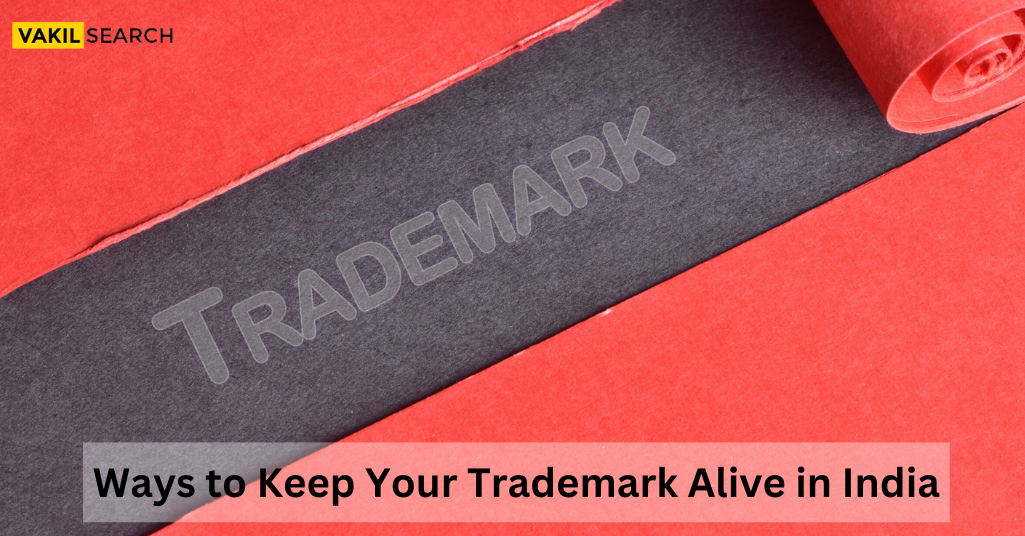Maintaining a trademark is a critical part of protecting your brand and its equity. As such, it's important to follow certain steps to ensure that your mark stays alive and breathing.
Introduction – Ways to Keep Your Trademark Alive in India
Protecting your trademark is crucial for maintaining brand identity and market presence in India. Once you have successfully registered your trademark, it is essential to take proactive steps to keep it alive and safeguarded from infringement or misuse. In this article, we will explore key strategies and practices to ensure the longevity and vitality of your trademark in the Indian market. From regular monitoring and enforcement to timely renewal, understanding the necessary steps will empower you to preserve the integrity of your trademark and reap the benefits of a strong brand reputation. Let’s delve into the essential measures required to keep your trademark alive in India.
What is a Trademark?
A trademark is a valuable business asset. It can help you protect your brand, products, and services from being copied or used by others. A registered trademark can also give you exclusive rights to use that mark in your industry.
A trademark is a valuable business asset that needs to be protected.
However, you can do a few things to make sure your trademark stays strong and doesn’t become ‘generic’.
- Use it regularly – You need to use your trademark regularly in order to keep it alive. This means using it in advertising, your website, and any products or packaging.
- Refer to it as a trademark – Always refer to your trademark.
Trademarks are registered with the Patent and Trademark Office. When you register your trademark, you will receive a certificate of registration, which is proof of your ownership. The office also maintains a database of registered trademarks, which is accessible to the public.
Before you begin the registration process, you can use Vakilsearch’s free trademark search tool to verify whether the trademark you want is available.
Why do you Need to Protect your Trademark?
A company’s intellectual property is one of its most important assets. This is especially true for trademarks, which identify the source of a product or service and distinguish it from those offered by other businesses. As a result, trademarks must be protected from unauthorised use by third parties, which can dilute their value and damage the company’s reputation. To guard against such infringement, businesses should take steps for trademark registration with the appropriate authorities and enforce their rights when necessary.
A trademark is a valuable business asset, and it’s important to take measures to protect it.
Here are four reasons why you need to protect your trademark:
1) A trademark can help you build brand equity.
2) A trademark can help you gain market share.
3) A trademark can help you protect your intellectual property.
4) A trademark can help you defend your brand against copycats.
Legal Protection for Registered Trademarks
The legal terrain arms registered trademark proprietors against infringement and the erosion of reputation by other entities. Infringement transpires when a mark identical or akin to a registered trademark is used without authorization. Legal redress can be sought, enabling the trademark owner to initiate legal proceedings against unauthorized users. This protective shield of registration offers an array of benefits distinct from those available to unregistered trademarks in India:
- Prima Facie Evidence of Validity and Ownership: A registered trademark serves as compelling evidence of its validity and ownership.
- Statutory Protection: The shield of statutory protection encompasses registered trademarks, bolstering their security.
- Restrains Unauthorized Usage: Registered trademarks thwart unlawful usage by others, asserting your exclusive rights.
- Facilitates Legal Action: Registered trademark proprietors can file suits against infringements, thereby safeguarding their mark’s sanctity.
Protection Against Trademark Infringement
Trademark registration confers exclusive rights upon the registered proprietor, enabling them to utilize the trademark for the corresponding goods and services. It empowers the registered proprietor to seek remedies against trademark infringement. To initiate a suit for trademark infringement in India, certain prerequisites must be met:
- The plaintiff must be the registered trademark owner.
- The defendant’s use of a deceptively similar mark to the plaintiff’s trademark.
- Usage of the mark in relation to the goods or services for which the plaintiff’s mark is registered.
- Usage of the mark in a commercial context, not accidentally.
Remedies for trademark infringement include temporary or permanent injunctions, accounting of profits, damages, destruction of infringing goods, and legal costs.
An Exception to the Grant Infringement Relief
Relief for damages or accounting of profits might not be granted if the defendant satisfies two conditions:
- The defendant was unaware that the plaintiff’s trademark was registered.
- The defendant ceased using the trademark for the goods or services upon discovering the plaintiff’s rights.
Legal Protection for Unregistered Trademarks
In India, the principle of first-to-use determines trademark ownership. Unregistered trademarks are shielded under common law through “passing-off” protection, which empowers trademark owners to take action against unauthorized users. Passing-off protection hinges on proving:
- Misrepresentation causing harm to another’s goodwill.
- Actual damage to the other party’s goodwill.
Unregistered trademark proprietors bear the onus of proving usage and prior rights. In contrast, in an infringement case, the defendant bears the burden of proving non-usage without authorization.
Passing Off Protection for Trademarks
Passing off is a common law remedy, safeguarding the goodwill tied to unregistered trademarks. It operates on the principle that one entity shouldn’t reap the rewards of another’s efforts. Courts consider:
- Plaintiff’s prior usage of the trademark.
- Distinctiveness of the plaintiff’s goods associated with the trademark.
- Defendant’s misrepresentation leading to consumer confusion.
Remedies for passing off include injunctions, accounting of profits, damages, and destruction of infringing goods.
How do you Protect your Trademark?
When starting a business, it is vital to protect your trademark. A trademark is any word, phrase, symbol, or design that can be used to identify the source of a good or service.
There are a few different ways to protect your trademark:
1) Register your trademark with the Patent and Trademark Office. This is the most vital type of protection and gives you exclusive rights to use your trademark nationwide.
2) Use the ® symbol next to your trademark. This indicates that you have registered your trademark.
What are the Benefits of Protecting your Trademark?
A trademark is one of the most important business assets a company can own. By registering a trademark, businesses can protect their brand and differentiate their products in the marketplace. Additionally, trademarks provide businesses with a number of valuable benefits, including: The ability to
- Exclude others from using their trademarks
- Sue others for trademark infringement
- Recover attorneys’ fees in successful lawsuits
- Stop counterfeiters from selling fraudulent or infringing products
Within the last decade, there has been a dramatic increase in the number of trademark lawsuits. Many small business owners mistakenly believe that federal registration of their mark is not necessary, or they wait too long to file and lose many of the benefits of protection.
Moreover, international trademark registration provides a number of valuable benefits to businesses, which are explained in more detail below:
- Nationwide protection
- Constructive notice to others of your ownership rights
- A searchable online database of registered trademarks
Understanding Trademark Maintenance
Below given are the tips to keep your Trademark alive in India-
Filing for Renewal
The procedure for filing for renewal may differ depending on the jurisdiction wherein the renewal action is sought. There is no limit to the number of times the renewal may be requested. However, suppose one wishes to continue enjoying the set of rights granted upon trademark registration after the expiration of the trademark’s duration, which is usually ten years from the date of application. Further, in that case, a renewal application must be filed. Although the Trademark Office sends an automated email, it is the responsibility of the holder of the corresponding rights to ensure that the renewal is filed before the due date. Hence, as a result, it is crucial to remember one’s renewal date.
Sending Cautionary Notices
It is essential for the rights holder to make public announcements to inform competitors and the general public that the trademark is his exclusive property and that any infringement will not be tolerated. Further, doing so establishes that the owners have published and made efforts to make their mark well known, preventing anyone from adopting it dishonestly. Also, when trans-border rights are pursued, it is beneficial to send cautionary notices to respective trademark offices that allow advertisements. This is true for countries such as Eritrea, the Maldives, and Myanmar.
Pay Your Taxes
Every year, trademark owners must pay their respective governments’ income taxes in an orderly and format.
Filing Affidavit of Use
The declaration of use or affidavit of use is frequently filed alongside the request for renewal in many countries. The owner of a mark is required to show a model that the trademark has been used in commerce on one of the goods and services in each international class, as claimed in the application for registration, in this legal document. A suitable example would be a specimen of the label affixed to the goods’ containers or boxes, literature available on the goods such as sale receipts or invoices, copies of advertisements, and so on.
FAQs –
1. Can a registered trademark be removed from the register?
It can be eliminated by submitting an application to the Registrar in the prescribed form on the grounds that the mark is incorrectly still on the register. Can the Registrar issue a Notice of Removal of a Registered Trademark on its own?
2. How much time will it take to get my trademark registered?
Trademark registration is time-consuming and can take 18-24 months in a direct case with no objections or opposition. On the other hand, the trademark application number is usually issued within one or two days of filing.
3. Can we use any trademark without registration?
Yes, you can use a trademark without registering it. This is referred to as an unregistered trademark. Check that it is not the same as another brand, logo, or name. A trademark must be distinguishable from those of others.
What are the protections under Trademark Act 1999?
The Trademark Act of 1999 provides legal mechanisms to protect registered trademarks against infringement and unauthorized usage.
How is a trademark protected in India?
What is the duration of trademark protection in India?
The duration of trademark protection for a registered trademark in India is ten years. This protection can be renewed indefinitely by paying renewal fees at the end of each ten-year period.
Hope this blog regarding “Ways to Keep Your Trademark Alive in India” was helpful.
Read More:-










